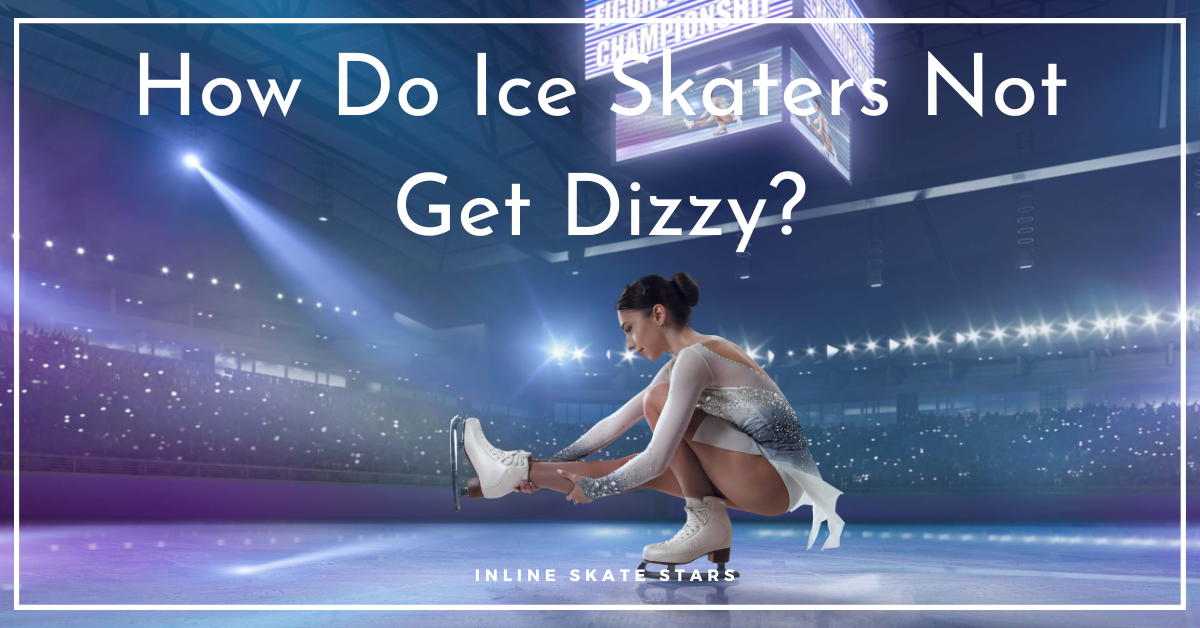How do ice skaters not get dizzy? Ice skating can be a fascinating and exhilarating experience, but it can also be quite dizzying.
If you’ve ever watched an Olympic figure skater, you might have been struck by how they manage to stay on their feet for long periods – and not get dizzy.
It’s no surprise that sometimes spectators feel woozy after watching a figure skating session.
There are a few tricks that ice skaters use to stay on their feet and not fall: they keep their heads up, they use a stable base, and they move in a smooth, controlled way.
In this article, I’ll show how these techniques help ice skaters stay safe and avoid dizziness.
How Do Ice Skaters Not Get Dizzy?
How do ice skaters not get dizzy? Ice skaters and Olympians don’t get dizzy or tumble because they’ve conditioned their bodies and brains to suppress the feeling of dizziness by controlling their vestibular system, which is responsible for body balance, coordination, and control. This technique is called Optokinetic Nystagmus.
According to Mirai Nagasu, a Winter Olympics bronze medal champion, figure skaters feel the rotations while turning but have learned to recenter their focus after years of training.
Below I elaborate on how it works!
What is the Vestibular System
It is obvious dizziness is unavoidable when ice skating.
But how do figure skaters manage not to get dizzy while at it? The answer is simple: they’ve learned to suppress the feeling by controlling their vestibular system and sensory receptors.
What is the vestibular system? You must be asking.
The vestibular system is responsible for body balance, coordination, and control.
It comprises two systems: the semicircular canals and the otolith organs.
The semicircular canals help you sense movement in your surrounding environment; this information is sent to the brain via the vestibulocochlear nerve.
The otolith organs are located within each ear and are responsible for maintaining equilibrium during head movements.
Together, these two systems keep you upright when moving around or standing still.
So, how does dizziness come about when the vestibular system should prevent it?
What Causes Dizziness?
Here’s a little bit about the science of dizziness.
According to MayoClinic and Scientific American, dizziness can be caused by inner ear disturbance/vertigo, motion sickness, and medication effects.
Ice skaters are more likely to fall prey to vertigo and motion sickness owing to the nature of the sport–the many spins and rotations involved.
Spinning around activates the rotation sensors. The head rotation triggers nystagmus due to repetitive eye movements.
Johns Hopkins University provides details about it here.
The eyes move in the opposite direction when spinning but stop before a full 360-degree turn.
Below I elaborate on what causes dizziness!
- Inner ear disturbance/vertigo: The inner ear is responsible for detecting movement and sending signals to the brain that tell you when you’re moving or standing. When the inner ear is disturbed, it can cause dizziness. Some common causes of internal ear disturbance include spinning or tilting your head too deeply while skating, a concussion, and otitis media (a middle-ear infection).
- Motion sickness: Motion sickness is a common condition caused by the feeling of movement when you’re not moving. The rest of the body becomes overwhelmed and reacts by throwing up or becoming very dizzy. Common causes of motion sickness include travel, changing elevations in altitude, and spinning rides, such as at an ice skating rink.
Figure skating is a highly competitive sport.
Now that the odds are stacked against figure skaters, they have to control their vestibular systems to prevent the spins and rotations from causing dizziness.
They use the same technique as ballet dancers.
If you’re wondering what this is, it is where the Optokinetic Nystagmus technique comes in handy.
More Reading>> Is Ballet or Figure Skating Harder?
What is the Optokinetic Nystagmus Technique?
The Optokinetic Nystagmus Technique is a body balance technique used to prevent dizziness.
It is also referred to as the “optic nystagmus.” The optokinetic nystagmus technique relies on the movement of the eyes to maintain balance.
The optokinetic nystagmus technique can be used to prevent dizziness in a few different ways.
- First, the optokinetic nystagmus technique can help keep your head upright when feeling dizzy.
- Second, it can help stabilize your position when you feel dizzy and have trouble keeping your balance.
- Finally, the optokinetic nystagmus technique can also help reduce feelings of vertigo.
How Does the Optokinetic Nystagmus Technique Work?
The Optokinetic Nystagmus Technique is a way to prevent dizziness while skating.
It works by using the eyes to move in opposite directions.
This process can help keep your head from spinning and causing dizziness because of inertia.
The optokinetic nystagmus technique is done by moving your eyes in a spinning motion.
How to Do the Optokinetic Nystagmus Technique
To do the optokinetic nystagmus technique, you must start sitting on a desk chair.
You should then lean your head back and look up at the ceiling. After a few seconds, you should slowly move your eyes in a spinning motion toward the ground.
You can keep moving your eyes in this direction for as long as possible to keep from feeling dizzy.
Alternatively, stand with your feet shoulder-width apart, and rest your hands on your hips or a stable object in front of you.
Look straight ahead and relax your eyes. Then move one eye horizontally until it circles 180 degrees (or 360 degrees if you’re using a mirror).
Hold this position for two seconds, then slowly move the eye back to its original post and continue the rotation with the other eye.
Repeat this process with each eye for three minutes per session.
Ice skaters use these drills to learn and master the Optokinetic Nystagmus technique.
While they’ll no doubt feel dizzy at the beginning of their careers, the feeling often goes away after years of training.
Other Techniques Ice Skaters Use to Avoid Dizziness
Besides the Optokinetic Nystagmus technique, ice skaters employ other techniques to avoid dizziness at the rinks.
They typically control their speed on the ice and move in smooth and regulated motions to prevent disturbance of their vestibular system.
Also, some Olympians or ice skaters generally avoid performing certain tricks in sequence.
For example, going from one triple axel into another one triggers dizziness.
Ice Skaters Control their Speed on the Ice
One of the essential things ice skaters do to avoid dizziness is to control their speed.
They don’t want to go too fast or too slow, as either movement can cause dizziness.
To ensure that they’re moving at a safe and controlled pace, they use figure skating techniques like spinning around the blocs (or circles on the rink) while keeping their arms and legs extended in front of them.
This allows them to maintain stability while skating at high velocity.
They Move in a Smooth and Controlled Way
Another way ice skaters maintain dizziness-free skating is by moving in a smooth and controlled manner.
They keep their head and body stationary, minimizing the amount of movement around their peripheral vision.
This allows them to focus on their figure skating moves and avoid disruptions in their vestibular system.
Common Google Search Queries Addressed!
1. Do skaters get dizzy when they spin?
Spinning can cause dizziness in some people, mainly if they’re not used to it.
However, spinning usually doesn’t lead to full-blown dizziness unless you do it for a long time or at high speeds.
Spinning is typically done for skaters while keeping their heads and body stationary.
2. How do you spin fast without getting dizzy?
Skaters can use a few techniques to avoid dizziness while spinning fast.
One is to keep their head and body stationary, spinning around the blocs or circles on the rink.
Another is to move in a smooth and controlled way, minimizing the amount of movement around their peripheral vision.
3. How do ice skaters keep spinning?
Some skaters keep spinning using figure skating techniques, like spinning around the blocs or circles on the rink and the Optokinetic Nystagmus technique.
4. How do Winter Olympics ice skaters not get dizzy?
The winter Olympics skaters use figure skating techniques like spinning around the blocs or circles on the rink while keeping their arms and legs extended in front of them.
This allows them to maintain stability while skating at high speeds.
They move in a smooth and controlled way, minimizing the amount of movement around their peripheral vision.
How Do Ice Skaters Not Get Dizzy? | Wrapping Up
How do ice skaters not get dizzy? This is one of the top Google queries asked by most figure skating spectators.
According to Brigid Dwyer, professor of neurology at Boston university school of medicine, dizziness is only a potential issue during faster and more forceful activities.
In summary, skaters use stationary figure skating moves and optokinetic nystagmus to avoid dizziness.
Skaters can use figure skating techniques like spinning around the blocs or circles on the rink to keep their heads and body stationary while spinning.
Olympic figure skaters use figure skating techniques that help them maintain stability and move smoothly, minimizing movement around their peripheral vision.




